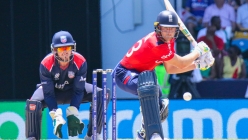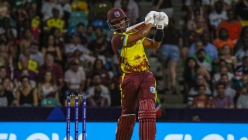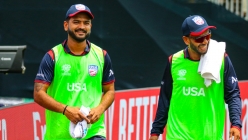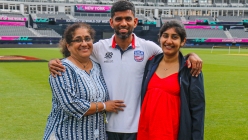Views
USA Cricket: 2024 ICC Women’s T20 World Cup Qualifier Tour Review Part 3 - Outlook for the Future
2024 May 14 by DreamCricket USA
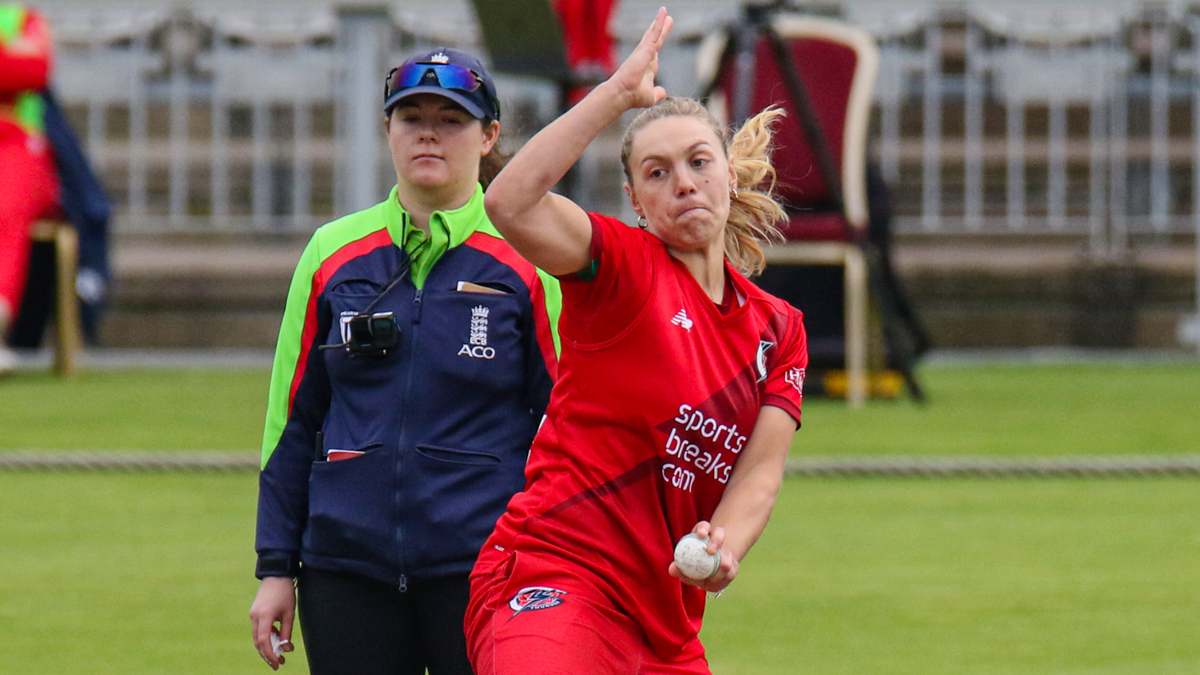
By Peter Della Penna (Twitter/X @PeterDellaPenna)Making drastic improvements to USA's fielding standards and ensuring that all eligible citizen players are integrated into the women's national team setup, whether they are based in the USA or are contracted overseas professionals like Thunder's Tara Norris, must be priorities going forward.
Photo credit: Peter Della Penna
1 – Put an extreme emphasis on fielding in player development and selection.
It has been clear for several tours now that fielding is rarely if ever considered when picking a USA Women’s squad. Lisa Ramjit and Tya Gonsalves never should have been left out of the 2023 USA Women's U19 World Cup team for those reasons. Ritu Singh is arguably USA’s best all-round fielder in the touring squad but sat on the bench for two matches. Gargi Bhogle is USA’s best catching fielder in the ring but sat out the last two matches. Chetna Reddy Pagydyala is another top fielder within the USA Women’s ecosystem and was dropped for this tour. As a result, the players who were put in the high-traffic boundary catching positions for USA wound up being incredibly weak. As a matter of fact, USA did not take a single boundary catch all tournament. If you look at the catches taken in the stats column, the only player who took one besides wicket-keeper captain Sindhu Sriharsha (four catches and two stumpings) was Jivana Aras, who latched onto a catch at short third. Otherwise, all other catching chances (seven of them) were put down.
It’s no accident that USA’s best ever win in Women’s T20Is came against UAE during a quad series match on tour in 2022 when Ritu Singh had arguably the best individual fielding performance ever by a USA Women’s player. Singh took the catch of the tour when she flew across the air at long-on to complete a diving effort to give Bhumika Bhadriraju a wicket. Later on, Singh had a direct hit runout from 40+ yards from the same position on the boundary to deny a second run. USA was only defending a meager total of 104 that day, but bowled out UAE for 79 thanks to some incredibly special fielding. Lisa Ramjit, another sure-handed fielder, also took a catch that day while Taranum Chopra also took a crucial catch at deep square leg to dismiss the dangerous Theertha Satish. Good fielding won USA that match against the UAE. Bad fielding has cost USA countless other opportunities at beating higher-ranked opponents and that was once again the case on this 2024 tour.
Watching USA practice their high catches and/or boundary catches during pregame warm-ups or at innings break intervals, multiple commentators and first-time observers of USA remarked that they felt the coaches were doing a bad job of preparing the players (at least compared to the genuinely high catching practice that all of USA’s opponents engaged in during their own pre-game warmups on the opposite half of the outfield) because the so-called “high catches” never really went more than 20 feet in the air and were often hit at a relatively flat trajectory from a short distance of about 20-25 yards. The counterpoint offered by this journalist was that the catching practice coordinated by the USA coaching staff was being hit lower and flat by design because it was clear that the coaches on tour recognized that USA’s fielders were incapable of catching genuinely high parabola arcing chances hit toward the boundary. So at the very least, USA’s coaching staff wanted to make sure they didn’t send any of their players to the hospital or dentist with a broken nose or missing teeth before the match had even started.
This is the most glaringly obvious sign that USA’s fielders are unathletic and possess weak hand-eye coordination, in particular compared to their opponents. USA’s boundary fielders look borderline terrified when a chance is hit their way during a live match. Chances are often misjudged with players slow to react especially in terms of charging forward, which almost never happens. Compare that to the fielders for Scotland and Sri Lanka, who charge in from the boundary like there’s no tomorrow when the ball is in the air and a chance is possible.
Rarely are USA’s fielder’s bodies positioned directly behind the ball with a chance in the air. Instead, their hands are almost always outside the frame of their shoulders and torso width, resulting in bad positional body and hand technique that contributes to the drops. But it’s simultaneously clear that the USA players don’t want to position their bodies and heads/faces behind the ball in the event that the ball bursts through their hands and hits them in the face. If their hands are outside the frame of their face/body when attempting a catch, at least there is the comfort in knowing that they will probably avoid serious injury. On the flip side, it severely diminishes the likelihood of catching the ball when there is so much hand and body separation in the technique.
Proper catching technique is something honed from a young age, often aided by playing multiple sports. To be blunt, it appears as though many of USA’s players have only begun to address catching practice well into their teens, and not address it in a serious manner either. At that stage, the ship has sailed. It is hard to envision that the majority of USA’s current squad will ever turn into good fielders. Arguably USA’s best boundary-catching fielder is Sindhu Sriharsha, yet she is adamant about remaining in her preferred position as wicketkeeper. Next in line is Ritu Singh, but she can’t field in all four boundary positions (and that’s if she’s even in the starting XI). Others have shown initial promise fielding on the boundary (Geetika Kodali, Isani Vaghela, Aditi Chudasama, Disha Dhingra) but have been error-prone. In the case of Kodali, she is often kept inside the ring in order to lessen the strain on a delicate shoulder by eliminating the probability of Kodali needing to make regular relays from long distance.
In most instances, USA’s players quite often are also slow to react when the ball is in play, which highlights their poor anticipation skills. This is especially true when it comes to rotational positioning movements to back up a throw. One of the most commonly repeated mistakes that cost USA several runout chances is a bowler’s lack of awareness after delivery in terms of getting back over the non-striker’s stumps to receive a possible relay from a fielder. That comes through repetitive practice simulations to build up situational awareness. It is second nature to Thailand’s bowlers to immediately get back over the stumps once the ball is in play off the bat – evidence that they practice this simulation on a regular basis – and it allows them to create and convert many runout chances. USA’s bowlers rarely if ever do this in match scenarios, so it doesn’t take a genius to deduce that it’s something they aren’t practicing outside of matches.
And none of this even scratches the surface in terms of the feebleness of USA’s throwing arms, whether from inside the ring or from the boundary. USA’s boundary fielders often relay the ball in on four or five bounces, and the throws from the edge of the circle are also weak, often released after taking three or four steps instead of a fluid collect and throw in the space of one step. USA Women’s interim head coach Charlotte Dickenson made several very pointed comments during post-match interviews on tour regarding her dissatisfaction with the training structures being facilitated by private academies dotted around the USA, and the lack of time spent on fielding was a major component of her criticisms.
Sending kids to these private academies around the USA does not come cheaply either. Which begs a couple of key questions: what is the actual return on investment? Is sending a kid to a private academy in the USA actually worth it if they clearly lack fundamental skills after seeing how their deficiencies are exposed on a global stage? The teenage female players in Scotland aren’t going to expensive private academies, yet their skills development is lightyears ahead of the USA players in the same peer group age brackets in all three facets of the game.
If there is going to be a change in fundamental fielding standards for the USA Women’s setup, it has to begin at local level. Local cricket coaches don’t spend nearly enough time on fielding practice, at least compared to the overwhelming volume of time spent on batting and bowling skills training (which doesn’t look like it is reaping rewards either). It means that arm strength isn’t developed. Far more worrying, neither is throwing accuracy. Target practice is a fundamental aspect of any sport, and in cricket, it’s pretty easy to coordinate in terms of throwing at the stumps. If a person doesn’t have a set of stumps at home, then it can be a chalk box drawn on a brick wall, or setting up a garbage can (Tom Emanski instructional video flashbacks anyone?), or a pyramid of 10 tennis balls on an empty court. There’s no shortage of creative solutions that can address and improve throwing accuracy from short, medium and long distance. Yet it doesn’t look like the majority, if any, of USA’s players are doing this.
Separately, throwing strength is a byproduct of athleticism developed through playing multiple sports. Too many of USA’s players (and this is not exclusively a female player issue) specialize in cricket way too soon when they should be playing as many sports as possible. Anyone who has seen Ali Sheikh throw a 40-yard tight spiral pass with an American football understands why it’s no surprise that he has a bullet of a throwing arm. It doesn’t need to be just football. Whether baseball/softball, basketball (chest passes and full-court inbounds throws), or through any number of other sports, there are ways that kids can and should be developing their arm strength outside of playing cricket, cricket, cricket and nothing but cricket. The fact that playing other sports outside of cricket offers social benefits and prevents burnout is an added bonus too.
The bottom line is that fielding isn’t taken seriously by players, coaches and selectors. Arguably, it never has been. A case in point is the instance of one particular player who was included in the USA U19 Women’s squad reserves for the 2023 ICC Women’s U19 T20 World Cup in South Africa despite the fact that her fielding technique was so weak to the point of being a genuine safety risk that she was hit in the face trying to catch a chance on the boundary during the 2022 USA Women’s Nationals in Texas and was spitting out blood from her mouth. Yet, the fact that she could not safely protect herself from injury in the field, let alone hold onto a catch, was completely disregarded by selectors because she wound up being included as one of USA’s five official squad reserves. It’s hard to find a better example of the non-existent discussions that take place around fielding when picking USA Women’s squads.
Until the culture changes around how players and coaches approach the fielding elements of the game – starting with training sessions and simulations before going into live match scenarios – USA will always look like they are behind their opponents, no matter what the state of their batting and bowling skills development is. When USA coaches and administrators at local, regional and national level begin to prioritize fielding, that is when results at tournaments like these might begin to turn around.
2 – Properly reintegrate USA’s overseas-based eligible players.
Tara Norris and Ella Claridge both attended the USA Women’s squad trials held at Florida in February. The fact that both then chose to not make themselves available for USA for the Qualifier is most easily explained by the fact that both are on professional contracts in the English domestic system – Norris with Thunder and Claridge with The Blaze – and USA Cricket was not going to compensate them for lost earnings if they skipped a significant number of matches in the Rachael Heyhoe Flint Trophy to begin the English domestic season.
But it’s not a problem unique to USA. Both Kathryn and Sarah Bryce are contracted with The Blaze, same as Ella Claridge. Abtaha Maqsood is contracted to Sunrisers. Hannah Rainey and Ailsa Lister are contracted to Thunder, same as Tara Norris. Rachel Slater is contracted to Diamonds. Priyanaz Chatterji is contracted to South East Stars. Somehow, all of these Scotland players were able to find a way to make themselves available for the qualifier.
On May 8, Claridge was part of an unbroken 139-run seventh-wicket stand for The Blaze to help her side recover from 137 for 6 to successfully chase a target of 276 with two overs to spare to defeat Western Storm by four wickets. In that innings, Claridge made 64 off 62 balls with seven fours and a six (did someone say six? Something absent from USA’s lineup in the UAE). Claridge also saved the Blaze in a two-wicket win over Northern Diamonds on May 1 by scoring 26 not out off 41 balls upon entering at No. 8.
As for Norris, she has four wickets in four matches so far this season with Thunder, including a best of 3 for 45 against Southern Vipers on May 1. She was good enough to take the first ever five-wicket haul in the WPL for Delhi Capitals in 2023. She also has three seasons of The Hundred under her belt, the first two with Southern Brave before switching to London Spirit in 2023 where she picked up a Player of the Match award (or Match Hero as it is known in The Hundred) in a win over Oval Invincibles.
On the whole, the USA Women’s selection philosophy of prioritizing locally developed players is commendable and the right thing to do for the long-term success and growth of the sport. But that doesn’t mean ignoring all eligible players, especially eligible citizens. In an ideal world, having a few players who are not locally developed should be the exception to the rule. The problem with the USA men’s team is that having players who are not locally developed has always been the rule, not the exception to the rule. The pendulum has gone too far in the opposite direction on the women’s side.
An ideal example to point to in terms of striking the right balance is what the Ireland men’s side did in their rise to Test status. Players like Niall and Kevin O’Brien, Paul Stirling, George Dockrell, William Porterfield, Ed Joyce and John Mooney formed the core of the team. But there was still plenty of room for a Trent Johnston or a Tim Murtagh to beef up the side.
A more pertinent and recent example in women’s cricket for USA to emulate is what the Scotland Women’s side achieved in this most recent Women’s T20 World Cup Qualifier. The Bryce sisters – Kathryn and Sarah – are the stars of the team while other locally developed talents such as Ailsa Lister, Darcey Carter, Abtaha Maqsood, Katherine Fraser and Lorna Jack form the nucleus of the side. However, other players not developed or based full-time in Scotland – Rachel Slater, Chloe Abel, Saskia Horley – all made their Scotland debuts since 2022 and played crucial roles in enhancing the overall squad depth to make them competitive enough to beat Ireland and Thailand in 2024.
Having Tara Norris and Ella Claridge in any USA squad would give USA immediate upgrades in several areas. First and foremost, USA’s fielding would drastically improve, especially in the catching department. Second, both players have six-hitting and power-hitting capabilities. Though both bat at No. 8 in their English franchise sides, realistically they would bat no lower than No. 5 in any USA XI. Putting them around Sindhu Sriharsha in a USA batting order would also ease a lot of the pressure off the captain. The professional experience that Norris and Claridge bring to the table can rub off on USA’s young homegrown players and should speed up their development.
3 – Implement a more coherent and consistent USA Women’s national team program.
Another reason that players like Norris and Claridge are reluctant to make themselves available for USA is the ad hoc nature of how the national team is organized. There is no continuity from tour to tour or between tours. The handling of interim head coach Charlotte Dickenson is a perfect case in point, with a sprinkle of Burt Cockley in between.
Rather than build off of the success of the Americas regional qualifier win in September by having a plan in place to prepare the players for the qualifier that was due to be held in early 2024, USA Cricket essentially sat on their hands for seven months as they stalled by not hiring and naming a full-time coach. Multiple candidates have contacted this journalist to express their disgust at the interview process in which there has been no follow-up for months after interviews were completed.
Aside from this, USA's lack of meaningful matches on turf wickets was also a major problem in the UAE as several technical flaws, first and foremost the problem of batters pushing too early at the ball with hard hands. It's hard to imagine this would have been as glaring a problem if USA Cricket had organized any sort of structured plan which involved either training camps or bilateral matches with a focus on gaining more experience on turf wickets in the leadup to the tournament in the UAE.
Instead of having fixtures, training camps and the coaching situation settled far in advance of the team's participation in the global qualifier, USA whipped together a hastily scheduled selection camp in Florida in the last week of February, for which they appointed Cockley to be in charge, in part based on his previous role as USA Women's assistant coach and strength & conditioning coach on several prior tours. However, USA Cricket then decided not to keep Cockley on board for the tour of the UAE itself due to what is believed to be a financial dispute between the two parties (a pay dispute in the world of USA Cricket? Shocking, I know).
After deciding not to offer Dickenson the job full-time following the team’s success in September, and after negotiations with Cockley fell apart, Dickenson was then hastily brought back into the USA fold for an even more hastily planned pre-tournament round of fixtures in Dubai and Abu Dhabi. The plan was for two ODIs and three T20Is to be played. But as the old saying goes, the best laid plans of mice and men often fall apart. It blew up in their faces when the T20I Quad series scheduled with Scotland, Netherlands and UAE was wiped out by a once every 75-year torrential rainstorm with flooding in Abu Dhabi. It meant USA hardly had any time to trial combinations for the qualifier, combinations that should have been sorted months earlier. Instead, they had two official warmups against Zimbabwe and Ireland, plus another last-minute fixture against UAE, and the team management just had to wing it.
Now that the tour of the UAE is over, Dickenson is unlikely to work with USA on a regular let alone permanent basis due to being based in New Zealand while Cockley has left the USA after taking a full-time job with the Queensland Bulls in Australian domestic cricket. It means that at least on the coaching side of the USA Women's national team setup, USA is once again back to square one.
Scotland’s success by comparison was months in the making. Their summer of 2023 began with a quad series in July held in the Netherlands that also involved Thailand. Prior to their European Regional Qualifier, they also organized matches against English domestic franchise Thunder (where Tara Norris plays) in August. After winning the European Qualifier held in Spain in September, Scotland had a five-match T20I series against Ireland in October, also done in Spain. Scotland also held multiple training camps for their squad in Spain during the winter prior to arriving early in the UAE. The Bryce sisters also traveled to the UAE in February – along with Claridge – as part of a pre-season tour for The Blaze franchise. Other members of the Scotland squad also traveled to India or the UAE as part of English franchise pre-season tours. The point is, Scotland’s players were not coming in cold out of the same winter that USA’s players were.
USA Cricket had announced at the AGM held in November that there was a tentative plan for USA Women to host matches in June. But June is 16 days away, and USA is also co-hosting the Men’s T20 World Cup in the same time frame. Since November, there has not been a peep said by anyone in the USA Cricket administration about what, if any, fixtures there will be for the USA Women for the rest of 2024 once the global qualifier has been completed.
If USA wants to have a better plan for success at future qualifiers, it would help to have a plan in place, literally any plan. Having a Women’s T20 National Championship scheduled for August (instead of say, holding it this past March before going off to the global qualifier) practically defeats the purpose of designing a domestic program for the aim of preparing players for international competition unless there is an international fixture list in place after domestic tournaments conclude. Not having a USA Women's national team head coach to oversee the direction of the national team program and domestic championships also makes it difficult to formulate a strategy in which the thinking is aligned between all parties.
USA Cricket needs to stop stalling and finally come to a decision on a permanent women's head coach - the position has been officially vacant since January 2023 - and work with that designated person to formulate a plan in which the domestic structures dovetail with a national team strategic plan. Otherwise, a women’s domestic championship turns into something that is simply a box ticked to fulfill ICC governance criteria and nothing more.
[Views expressed in this article are those of the author, who was present in Abu Dhabi for all T20 matches on USA's tour of the UAE, and do not necessarily represent the views of DreamCricket management. If you have different views or viewpoints, we respect those views and urge you to provide your feedback, both positive and negative. Feel free to respond to the author via Twitter/X @PeterDellaPenna.]
